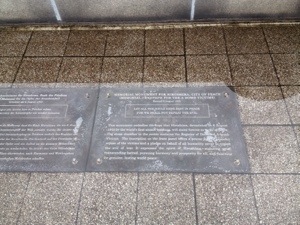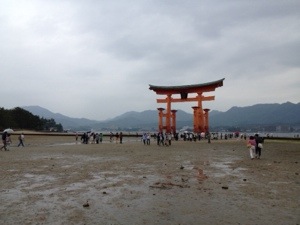Every trip I take, I always find a place that resonates with me. A place where, if I had to move to that particular country, I could totally live. In Vietnam, it was Hue; in China, it was Shanghai; in Italy, it was a toss-up between Stresa and Assisi; in the Former Yugoskavia, it was Sarajevo; in Turkey, it was Izmir; and in Greece, it was any of the Greek Islands. In Japan, Hiroshima is the place I could totally live if I moved here.

It was a six hour train journey to get to Hiroshima from Kinosakionsen, which is basically on the other side of Honshu, heading south. I had to catch two trains, with a change at Shin-Osaka to catch the Shinkansen to Hiroshima. The journey, like every train journey in Japan that I’ve been on, was visually feast.
When I arrived in Hiroshima, I breathed a huge sigh of relief that this station was not at all confusing, with Kyoto (in my book, anyway) winning my award for the station most likely to cause confusion. Being tired from my a poor sleep the night before (ryokans, despite their minimalism, are not restful), and not quite sure of the tram situation, I splurged and took a cab to my hotel.

The drive into my hotel was delightful. Spring has certainly arrived in Hiroshima, with pink and white azaleas, red and mauve tulips, and purple and gold pansies in full bloom. The trams give the city a cool retro vibe, while the bridges that arch gracefully over wide, green rivers whisper tales of romance and a hint to bygone era.

Of course, one cannot stay in Hiroshima without visiting the Peace Park, which I did. I found it profoundly moving, as I do with anything related to war*. The park itself is beautiful. And peaceful. And the museum tells the story of the history of Hiroshima, the A-bomb and the damage it did to the city, surrounds and its people through photos, artifacts and models. And why Hiroshima is a city dedicated to peace. I got quite teary seeing photos of the victims and hearing their personal stories of tragedy and survival.

I walked through the park, past throngs of tiny children, on an excursion from a local kindergarten. They ran and chatted and laughed in their navy uniforms and orange hats, and I wondered if they understood or comprehended the significance of what they had seen and heard today. There were a few foreign tourists, but the crowd was mostly Japanese. (I was heartened to read in the museum of the Japanese acknowledgement of the slaughter of hundreds of thousands of Chinese at Nanking. I heard when I was in Singapore that Changi is a blackspot in Japanese history books.)

It was a rainy day in Hiroshima, and I’m glad. I think the sun would have dulled true sombre, reflective nature of my experience if it had been its bright, gaudy self.

And one cannot miss Miyajima Island, either, renown for the giant torii gate that looks like its floating in the sea at high tide. I took a tram to Hiroshima Station, a train to the port, then a ferry to the island (I’m all across this transport situation!), and watched as scenery flashed, then meandered by.

The island itself was touristy, but catering more for the Japanese market than the foreign one, although I saw more foreigners here than just about anywhere else in Japan apart from the tiny bus from Magome to Tsumago! Miyajima is home to a population of wild deer, who are really quite tame and seemingly used to people taking “selfies” with them (guilty!).

The kilometre stroll to the giant torii gates, through shops and restaurants, was made all the more magical by the light rain. Unfortunately, it was low tide, but I can imagine how the gates would look submerged in seawater, and understand why this location is on the map for many of Hiroshima’s tourists. Even exposed, with its barnacle encrusted vermillion posts, this gate was impressive.

All in all, Hiroshima has left its mark indelibly burned into my soul. And it has earned its spot as One Of The Places I Could Totally Live If I Moved Here.
* I was moved to tears at Gallipoli; I could only stay inside the War Remnants Museum in Saigon for 20 minutes because it was so sad; I was both horrified and uplifted at Changi; and I felt such an overwhelming sense of sadness and loss walking through the cemetery in Mostar, where most of the headstones commemorated young men aged 19 or 20, killed in 1993…

No Comments